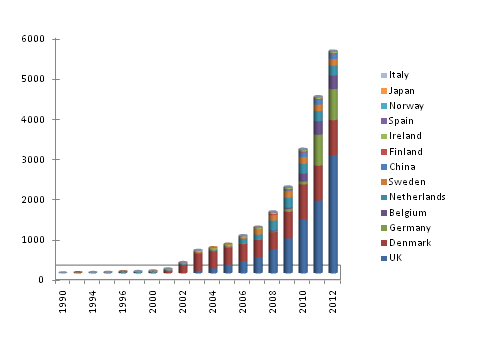


|
Offshore Wind Energy |
|
In March 2009 at the European Wind Energy Conference, EU put a target of reaching 230 GW installed wind capacity by 2020. 40 GW of this capacity will be provided from offshore wind. In order to reach 40 GW capacity, the offshore wind industry should grow annually 28% on average. Despite the financial crisis the annual growth in 2009 was around 41% and when the worldwide total capacity of proposed offshore projects are considered the 2020 target for Europe seems achievable. |

|
Worldwide Cumulative Installed and Under Construction Offshore Wind Capacity 1990-2012 (MW) [1] |
|
Wind is a renewable, free, secure and domestic resource that emits no greenhouse gases. When compared to onshore, offshore wind has several advantages such as: · Availability of large areas for plenty of turbines · Higher and more uniform wind speeds · Low roughness class and less turbulence · Close proximity to the coastal areas where electricity demand is generally higher · Theoretically less wake effects due to the increased distance between turbines hence higher park efficiency
However it has a major disadvantage of having a higher cost due to: · Use of more expensive materials · Need for expensive insulation against harsh sea conditions · Integration of cables into electrical grids (generally into weak coastal grids) · Higher maintenance and operation costs · And also the uncertainty for almost all of the design related issues.
Offshore wind energy is only feasible when considered within a larger system, typically called offshore wind energy conversion system (OWEC). For the last three decades the cost of onshore wind energy decreased more than 80%. And according to some scholars this trend will continue in the offshore wind systems too.
|

|
Cost of Wind Generated Electricity (cents/kWh, 2008$) For a site average 8-9 m/s wind speed [2] |
|
For more information please see Ozkan D., (2010), “Financial Analysis and Cost Optimization of Offshore Wind Energy under Uncertainty and in Deregulated Power Markets”, Washington DC, The George Washington University, Ph.D. |
|
Copyright Ó 2010 Deniz özkan |
